-
Folkways Fast Five: Dan Sheehy
Fast Five is a five-question speed interview with members of the Smithsonian Folkways Recordings staff.
Hello and welcome to Fast Five, where we at Smithsonian Folkways Recordings talk to a member of the staff about their favorite parts of the collection. I’m Hannah Judd, and I’m here today with Dan Sheehy. Could you introduce yourself?
I’m Dan Sheehy, I’m director and curator of Smithsonian Folkways Recordings.
What was your first Folkways album?
 My first Folkways album was a 10-inch LP with a drawing of Pete Seeger on the front [Lonesome Valley - A Collection of American Folk Music]. I couldn’t tell you right now what the name of the album was, but I think it had “Red River Valley” in it, it had some of the Western ballads that we think of as the most common—at least we used to think it, I don’t know what people think of it today—that Pete Seeger took from other sources and then made this album. It was 10-inch, so it must have been a 50’s or early 60’s album.
My first Folkways album was a 10-inch LP with a drawing of Pete Seeger on the front [Lonesome Valley - A Collection of American Folk Music]. I couldn’t tell you right now what the name of the album was, but I think it had “Red River Valley” in it, it had some of the Western ballads that we think of as the most common—at least we used to think it, I don’t know what people think of it today—that Pete Seeger took from other sources and then made this album. It was 10-inch, so it must have been a 50’s or early 60’s album.What are some of your current favorite albums? What do you like about them?
Well, as you can imagine, since I do this day-in and day-out for the last fifteen years, and being the curator I have a pretty major say in what’s going to be published here, I have many favorites. I can’t imagine publishing something that I really don’t like, so that’s going to be tough. I’m sure everybody on the Folkways staff is going to have a hard time deciding which are their favorites or narrowing it down to one or two.
 Off the top of my head, the first one that comes to mind is a recording entitled, Si, soy llanero: Joropo Music from the Orinoco Plains of Colombia. You know I work a lot Latin American and Latino USA, so a lot of my favorites are going to be those that follow my passions. This is a recording that was produced by—with me—Carlos Rojas, who’s a great musician in Colombia, a harpist and superb organizer and a person of exquisite taste. He put together an all-star multigenerational group of musicians who played the style of music from the Eastern plains of Colombia, the plains that have the tributaries that flow into the Orinoco River, that then in turn go through Venezuela and out into the Atlantic ocean.
Off the top of my head, the first one that comes to mind is a recording entitled, Si, soy llanero: Joropo Music from the Orinoco Plains of Colombia. You know I work a lot Latin American and Latino USA, so a lot of my favorites are going to be those that follow my passions. This is a recording that was produced by—with me—Carlos Rojas, who’s a great musician in Colombia, a harpist and superb organizer and a person of exquisite taste. He put together an all-star multigenerational group of musicians who played the style of music from the Eastern plains of Colombia, the plains that have the tributaries that flow into the Orinoco River, that then in turn go through Venezuela and out into the Atlantic ocean.The concept, I thought, was very good, it was Carlos’s concept mainly, and that was to in certain key instruments take three generations, of bandola player, for example, and show, say in the 1980’s or 70’s what the epitome of style was, and then move it into the 1990’s when another generation came along and changed the style a little bit with new directions and creativity, and then at the time, this was about 2004, as I recall, the youngest generation that had come along, that added a whole flamenco-sounding twist to it, and flourishes. I have to say I’m totally predisposed to love the music called joropo from the Eastern plains of Colombia and the Western plains of Venezuela, so I was ready to like this before we even did it, but the concept made it even more attractive to me and the execution was just first-rate, it really surpassed my expectations.
That recording led to the creation of the group Cimarrón, which means “wild bull,” the wild bull out in the savanna, and it was just the right name for me because of that spirit in the first album that we did with them.
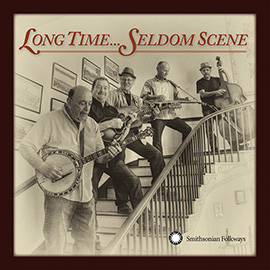 One of my absolute favorites among our more than 3,200 albums is Long Time…Seldom Scene,a recent one that our audio engineer, our sound production supervisor Pete Reiniger actually produced, with one of the most beloved of all bluegrass groups, The Seldom Scene, and there was a long story to that. We did an album on the occasion of their 40th anniversary that looked back over the years and pulled out some of their gems, and did a new interpretation of them. I’ve come to, during my years at Smithsonian Folkways Recordings, come to really love bluegrass music, good bluegrass music, and the Seldom Scene have a signature sound that is very compelling, very attractive, and I can’t imagine that just about anybody wouldn’t be grabbed by it.
One of my absolute favorites among our more than 3,200 albums is Long Time…Seldom Scene,a recent one that our audio engineer, our sound production supervisor Pete Reiniger actually produced, with one of the most beloved of all bluegrass groups, The Seldom Scene, and there was a long story to that. We did an album on the occasion of their 40th anniversary that looked back over the years and pulled out some of their gems, and did a new interpretation of them. I’ve come to, during my years at Smithsonian Folkways Recordings, come to really love bluegrass music, good bluegrass music, and the Seldom Scene have a signature sound that is very compelling, very attractive, and I can’t imagine that just about anybody wouldn’t be grabbed by it.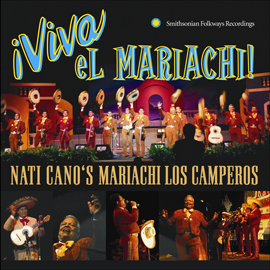 I’m a longtime mariachi performer, Mexican mariachi music, and a longtime follower of what I consider to be most pioneering and impactful on a younger generation of Mexican-Americans particularly, and on mariachi music in general in the United States, a group called Mariachi Los Comperos de Nati Cano. Nati Cano was a man who emigrated from Guadalajara, originally from a town in Jalisco, and took over this group in Los Angeles and turned it into Mariachi Los Comperos as we know it today, and that was in like 1961. The artistry, the musicianship, the way it fits into the whole social dynamic in the United States makes the five recordings we’ve done with him really impactful. It’s tough for me to decide which one I like the best, one of them won a GRAMMY, Amor, Dolor y Lagrimas: Música Ranchera, another was nominated for a GRAMMY, maybe the first Mariachi recording nominated for a GRAMMY, ¡Llegaron Los Camperos!: Nati Cano's Mariachi Los Camperos, “the Comperos have arrived,” as that translates to. Recently I have been listening to the first one we did, called ¡Viva el Mariachi!, in 2004 I believe, and it’s just so listenable to, and I like every tune on the album, so that has to be counted among my favorites as well.
I’m a longtime mariachi performer, Mexican mariachi music, and a longtime follower of what I consider to be most pioneering and impactful on a younger generation of Mexican-Americans particularly, and on mariachi music in general in the United States, a group called Mariachi Los Comperos de Nati Cano. Nati Cano was a man who emigrated from Guadalajara, originally from a town in Jalisco, and took over this group in Los Angeles and turned it into Mariachi Los Comperos as we know it today, and that was in like 1961. The artistry, the musicianship, the way it fits into the whole social dynamic in the United States makes the five recordings we’ve done with him really impactful. It’s tough for me to decide which one I like the best, one of them won a GRAMMY, Amor, Dolor y Lagrimas: Música Ranchera, another was nominated for a GRAMMY, maybe the first Mariachi recording nominated for a GRAMMY, ¡Llegaron Los Camperos!: Nati Cano's Mariachi Los Camperos, “the Comperos have arrived,” as that translates to. Recently I have been listening to the first one we did, called ¡Viva el Mariachi!, in 2004 I believe, and it’s just so listenable to, and I like every tune on the album, so that has to be counted among my favorites as well.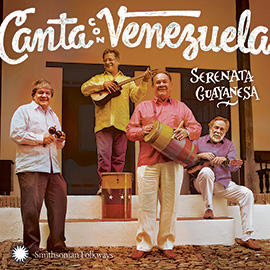 More recently, we traveled to Venezuela and recorded a group that was organized in about 1971 [Serenata Guayanesa, ¡Canta con Venezuela! Sing with Venezuela!]. It was a group that drew from music in different regions and different styles of Venezuelan music, and created a sound and a repertoire and a show, a performance, that could relate to all Venezuelans and ideally connect Venezuelans from different backgrounds into a unified sense of, “We’re all Venezuelans, no matter what our region is that we come from.” These days when there’s a lot of dissension in Venezuela, I thought it might be a good idea to record this group and really push it forward as a cultural glue that really holds people together, and could maybe reinstill in some small way a sense of unity across philosophical or political division, so that’s another one of those.
More recently, we traveled to Venezuela and recorded a group that was organized in about 1971 [Serenata Guayanesa, ¡Canta con Venezuela! Sing with Venezuela!]. It was a group that drew from music in different regions and different styles of Venezuelan music, and created a sound and a repertoire and a show, a performance, that could relate to all Venezuelans and ideally connect Venezuelans from different backgrounds into a unified sense of, “We’re all Venezuelans, no matter what our region is that we come from.” These days when there’s a lot of dissension in Venezuela, I thought it might be a good idea to record this group and really push it forward as a cultural glue that really holds people together, and could maybe reinstill in some small way a sense of unity across philosophical or political division, so that’s another one of those.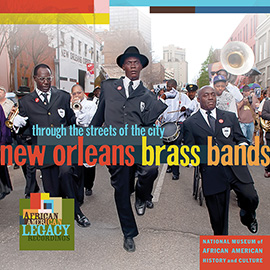 We have a series, the African-American Legacy Series, that’s filled with going on nine recordings, and one of those is New Orleans Brass Bands: Through the Streets of the City. It’s the brass band music that is now the signature sound of New Orleans. If you go to New Orleans, the French Quarter or wherever in that central area, you’re probably going to end up hearing bands playing on the streets. We spent a great four days with three of the top groups, the Hot 8, the one from the HBO series, the Liberty Band, and the Treme band. How can anyone not really love that music? It just reaches out and grabs you with those brass instruments and percussion and saxophone and singing, and that’s going to go down in my own personal history as one of my favorites.
We have a series, the African-American Legacy Series, that’s filled with going on nine recordings, and one of those is New Orleans Brass Bands: Through the Streets of the City. It’s the brass band music that is now the signature sound of New Orleans. If you go to New Orleans, the French Quarter or wherever in that central area, you’re probably going to end up hearing bands playing on the streets. We spent a great four days with three of the top groups, the Hot 8, the one from the HBO series, the Liberty Band, and the Treme band. How can anyone not really love that music? It just reaches out and grabs you with those brass instruments and percussion and saxophone and singing, and that’s going to go down in my own personal history as one of my favorites.What are some hidden gems in the collection?
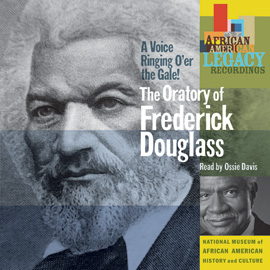 Hidden gems? There’s one I can’t help but talk about periodically, and that is a recording that came out of the Folkways Records collection, a compilation for that same African-American Legacy Series, it’s not music, and you know I’m from a music background. But this is a recording of some of the speeches of Frederick Douglass [A Voice Ringing O'er the Gale! The Oratory of Frederick Douglass Read by Ossie Davis], who of course was a great 19th century African-American orator and writer and civil rights and maybe not as well known, was a women’s rights leader-advocate as well. And Ossie Davis did an incredible job of taking these words of Frederick Douglass and turning them into oratory. I was listening to this, you know before we publish things I always listen to the audio, and I remember being in the gym during my workout, and I was on the running machine, the treadmill, and I had to get off the treadmill because it was so distracting—the oratory was so powerful, the words were so powerful, the message was so powerful. I said, “If I stay on this treadmill, I’m going to hurt myself,” so I got off the treadmill to listen to the rest of it, and to this day it’s just spine-chilling. Just thinking about this right now, this very moment, I feel a chill go down my spine because it was such a powerful experience listening to that recording. It snuck up on me, because it’s oratory, and you know, it’s beyond in a way, in most ways, beyond the realm of music.
Hidden gems? There’s one I can’t help but talk about periodically, and that is a recording that came out of the Folkways Records collection, a compilation for that same African-American Legacy Series, it’s not music, and you know I’m from a music background. But this is a recording of some of the speeches of Frederick Douglass [A Voice Ringing O'er the Gale! The Oratory of Frederick Douglass Read by Ossie Davis], who of course was a great 19th century African-American orator and writer and civil rights and maybe not as well known, was a women’s rights leader-advocate as well. And Ossie Davis did an incredible job of taking these words of Frederick Douglass and turning them into oratory. I was listening to this, you know before we publish things I always listen to the audio, and I remember being in the gym during my workout, and I was on the running machine, the treadmill, and I had to get off the treadmill because it was so distracting—the oratory was so powerful, the words were so powerful, the message was so powerful. I said, “If I stay on this treadmill, I’m going to hurt myself,” so I got off the treadmill to listen to the rest of it, and to this day it’s just spine-chilling. Just thinking about this right now, this very moment, I feel a chill go down my spine because it was such a powerful experience listening to that recording. It snuck up on me, because it’s oratory, and you know, it’s beyond in a way, in most ways, beyond the realm of music.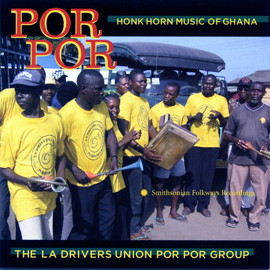 This may be just me, but the Por Por recording of Music from the Truck Driver’s Union of Ghana [Por Por: Honk Horn Music of Ghana] is a really interesting kind of music, unexpected, atypical of everything else in that the instruments that come forward the most are these klaxon horns, they go “honk, honk, honk,” you squeeze them. They’re a truckers union in Accra, the capital of Ghana. They’ve created music that draws from the different ethnic traditions in Ghana, you know, there’s Ewe, there’s Ashanti, there’s Fante, there are a lot of different cultural groups in Ghana. But the Trucker’s Union is a trucker’s union, so people from different backgrounds get there. They created this whole repertoire of music with these “honk honk honk” horns being played like drums, so there’s the interlocking typical West African sound. Steven Feld, who’s a phenomenal thinker and recordist, made recordings of this music during an extended stay in Ghana, and sent it to us, and I couldn’t resist and we published that. Might be interested to know if anyone else in the world liked it. But I’ll tell you this, I sure do.
This may be just me, but the Por Por recording of Music from the Truck Driver’s Union of Ghana [Por Por: Honk Horn Music of Ghana] is a really interesting kind of music, unexpected, atypical of everything else in that the instruments that come forward the most are these klaxon horns, they go “honk, honk, honk,” you squeeze them. They’re a truckers union in Accra, the capital of Ghana. They’ve created music that draws from the different ethnic traditions in Ghana, you know, there’s Ewe, there’s Ashanti, there’s Fante, there are a lot of different cultural groups in Ghana. But the Trucker’s Union is a trucker’s union, so people from different backgrounds get there. They created this whole repertoire of music with these “honk honk honk” horns being played like drums, so there’s the interlocking typical West African sound. Steven Feld, who’s a phenomenal thinker and recordist, made recordings of this music during an extended stay in Ghana, and sent it to us, and I couldn’t resist and we published that. Might be interested to know if anyone else in the world liked it. But I’ll tell you this, I sure do.Ghana at the time we published that was celebrating its 50th anniversary of independence, so it was a nice time to raise the visibility of this worker’s music at a time when Ghana was looking at its past, and to be able to look forward as an independent country. So it was a nice storyline. My philosophy as a curator is to look for two main things: a great sound or great listen, and a great story, and when I say great story it might be like the story of the trucker’s union and their music in Ghana on their 50th anniversary of independence, or it might be that the Si, soy llanero: Joropo music from the plains of Colombia, that one of their interests in doing a recording with Smithsonian Folkways recordings was to highlight, bring their music greater visibility, in Colombia, because historically Colombia’s very chopped up geographically, and so the power center has been the historic power center in the Andes, in Bogotá, the capital, which is where people more of Spanish descent settled and all that, and so the Afro-Carribeans, the Afro-Pacific people, the plains cattle herders, now a lot of oil is part of the economy there, to a certain extent they didn’t feel part of the whole. After we published the recording, it was nominated for a GRAMMY, and it got headlines in the culture section of the main newspaper of Colombia, el tiempo, on the first page of the culture section, and it was hailed as the first recording of Colombian music made in Colombia, because we traveled to Bogota to do that, that ever received a GRAMMY nomination, and I had no idea that was the case, but that just made it all the more special, in Colombia, to have that be part of that story.
What’s your favorite album art?
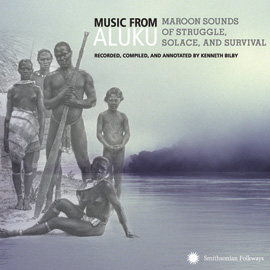 Well, that’s a good question. We put a lot of attention into cover art here, and I work very closely with Mary Monseur, our production manager, to work with designers, to get images and all that. So, from my point of view, our cover art tends generally to be of pretty high quality, and speaks to the tradition of high quality cover art with Folkways records, which as you may know very well, featured artists like Ronald Clyne and other folks that really were part of that New York City milieu in the 50’s, 60’s, and into the 70’s and maybe even early 80’s, and so what we’ve tried to do is keep our standards high for that. Just to give you a little maybe off-center favorite, we did a recording in our new digital series, we call it D2D, direct to digital, and it’s music of the Aluku Maroons of Surinam [Music from Aluku: Maroon Sounds of Struggle, Solace, and Survival], and it was the second album we did that was born digital, designed for the digital environment, and then converted to our custom discs. The care and the striking colors and the very meticulous design with maps and symbolic sketches of Surinam Maroon people, and just the general presentation in the new format will always be, for me, because I was paying a lot of attention to this series, and we were trying to make it work from a visual point of view, as well as an audio point of view, and the fact that that turned out so well just really, at that point in time, they say your strongest memories are determined by the emotions associated with them, and that was such a beautiful moment. Seeing that, the beautiful presentation of that second digital album we did, will go down in my memory as one of the most pleasing moments in terms of cover design in Folkways history.
Well, that’s a good question. We put a lot of attention into cover art here, and I work very closely with Mary Monseur, our production manager, to work with designers, to get images and all that. So, from my point of view, our cover art tends generally to be of pretty high quality, and speaks to the tradition of high quality cover art with Folkways records, which as you may know very well, featured artists like Ronald Clyne and other folks that really were part of that New York City milieu in the 50’s, 60’s, and into the 70’s and maybe even early 80’s, and so what we’ve tried to do is keep our standards high for that. Just to give you a little maybe off-center favorite, we did a recording in our new digital series, we call it D2D, direct to digital, and it’s music of the Aluku Maroons of Surinam [Music from Aluku: Maroon Sounds of Struggle, Solace, and Survival], and it was the second album we did that was born digital, designed for the digital environment, and then converted to our custom discs. The care and the striking colors and the very meticulous design with maps and symbolic sketches of Surinam Maroon people, and just the general presentation in the new format will always be, for me, because I was paying a lot of attention to this series, and we were trying to make it work from a visual point of view, as well as an audio point of view, and the fact that that turned out so well just really, at that point in time, they say your strongest memories are determined by the emotions associated with them, and that was such a beautiful moment. Seeing that, the beautiful presentation of that second digital album we did, will go down in my memory as one of the most pleasing moments in terms of cover design in Folkways history.Thank you so much for this opportunity to talk.
Folkways Fast Five: Dan Sheehy | Smithsonian Folkways Recordings

